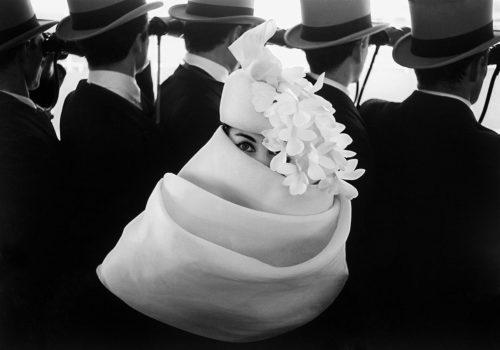The Jeu de Paume pays tribute to the photographer Frank Horvat, who passed away on October 21, 2020 at the age of ninety-two, with an exhibition presented at the Château de Tours until October 30, 2022. Accompanied by a monograph, it brings a renewed vision of the fiery activity of the photographer during the first fifteen years of his career, from 1950 to 1965, a period during which he affirmed an extraordinary personality as author-reporter and fashion photographer.
Born in Abbazia, Italy in 1928 to Jewish parents from Central Europe, Francesco Horvat was forced to take refuge in Switzerland in 1939, near Lugano, with his mother and sister. He lent to Milan after the war, he tried his hand at advertising and then as a photographer. His first images were published in the early 1950s by the Italian and Swiss newspapers Epoca, Die Woche and Sie und Er.
An admirer of Henri Cartier-Bresson, whom he visited in Paris in 1951 in the hope of joining the Magnum photos agency, he acquired a Leica and made his first initiatory trip to Pakistan and India from 1952 to 1954.
Managing to capture close-ups of scenes of great intensity and sometimes forbidden places, he proved to be a photographer of the body and the intimate.
Following Die Wöche, the major international magazines Paris-Match, Picture Post, Le Ore or Life published it under the name of Franco, then Frank Horvat, and Edward Steichen selected one of his images of Pakistan for the exhibition The Family of Man at the Museum of Modern Art in New York (MoMA). His career as a photo-reporter continued in London and Paris, where he settled at the end of 1955. In his reports on Parisian nights, striptease, cabarets, music halls and even places of prostitution, he captured the attitude of spectators-voyeurs and the show itself.
It was during this period that he acquired a Novoflex telephoto lens and tried out a large number of new viewpoints of Paris, exacerbating the effect of grain, contrast and using shallow depth of field, the saturation of the public space and the anonymity of the crowd.
Romeo Martinez, publisher and editor-in-chief of the magazine Camera, devoted twenty pages to this work in the January 1957 issue and exhibited it at the First Venice Biennale of Photography the same year.
These are the street images, pick up by several European photographic magazines, which paradoxically led him to fashion. Through William Klein, who noticed his images in Camera, he started a working relationship with Jacques Moutin, the artistic director of Jardin des Modes.
The latter offered him to transpose his style of urban photography, grainy, with natural light and in small format, to stage fashion collections and particularly ready-to-wear, then in full expansion. It is thanks to him that he produced his most famous images, such as Tan Arnold in the brasserie au chien qui fume or that of the woman in the Givenchy hat observing an imaginary race through binoculars. This irruption of a lively, humorous and offbeat “reportage spirit” in fashion photography seduced other magazines and Frank Horvat became a successful photographer. Monique Dutto at the metro exit, Nico in the Bois de Boulogne, Ana Karina in Les Halles appeared in Jours de France. His work and his approach were considered innovative in fashion circles. His natural scenarios were transformed into sophisticated compositions in the images he produced for British Vogue and Harper’s Bazaar from 1960 to 1962. Simone d’Aillencourt, China Machado or Vera Valdez, women with unusual backgrounds, posed in front of his lens.
Frank Horvat, however, felt from this time the desire to escape from the stereotyped codes of photojournalism and fashion photography. Supported by the director-in-chief of the German reportage magazine Revue, he undertook a vast photographic essay around the world for eight months, which took him to Cairo, Tel Aviv, Calcutta, Sydney, Bangkok, Hong Kong, Tokyo, Los Angeles, New York, Caracas, Rio de Janeiro and Dakar between 1962 and 1963. In this last great black and white report, he gave free rein to the expression of his fascinations and to a personal inspiration with sometimes hallucinatory vibrations. Games of gaze, night scenes, fragility glimpsed behind masks, melancholy of bodies, physical and romantic troubles, draw an intimate cartography of this photographer driven throughout his life by introspective research and an inexhaustible quest for new experiences.
Made from the important archives and writings left by the photographer in his home-studio in Boulogne-Billancourt, the exhibition includes 175 prints and 55 period documents (publications, writings, books, contact sheets). It presents, alongside emblematic images, sets of lesser known or completely unpublished photographs. The richness and uniqueness of a complex and multifaceted work are thus revealed, placed in the context of the history of the photographic image and the post-war illustrated press.
Virginie Chardin, curator of the exhibition and specialist in the history of photography, is the author of several exhibitions and books on the unpublished archives of photographers such as Willy Ronis, Sabine Weiss or Pierre de Fenoÿl.
Frank Horvat
jusqu’au 30 octobre 2022
Jeu de Paume – Château de Tours
25 avenue André-Malraux
37000 Tours, France
www.tours.fr
Frank Horvat 50-65
Texts by Virginie Chardin and Susanna Brown, foreword by Quentin Bajac and epilogue by Fiammetta Horvat
Joint edition of Jeu de Paume / Éditions de La Martinière, Paris
Bilingual French/English edition
24 x 28.5 cm – 288 pages, 235 black and white and color illustrations
ISBN : 979-1-0401-1154-2
Prix : 45 €
https://www.editionsdelamartiniere.fr/
















